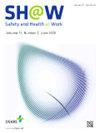Management and Collection of Occupational Data for Health (ODH) in National Public Health Statistics: Evaluation and Recommendations for Korea
IF 2.9
3区 医学
Q1 PUBLIC, ENVIRONMENTAL & OCCUPATIONAL HEALTH
引用次数: 0
Abstract
Background
The aims of this study are to examine how occupation-related data and information for health (ODH) are collected and managed from census-based surveys and potential occupational illness and injuries (POIS) statistics, and to propose a national strategy for the systematic collection, analysis, and management of ODH by building on the Korean Standard Classification of Occupation (KSCO) and using a job exposure matrix (JEM).
Methods
The status of the collection and management of ODH registered as national statistics, drawn not only from the census-based general population and workforce, but also from POIS statistics was reviewed and evaluated.
Results
ODH from the Republic of Korea's Census of Population and Labor Force are collected and classified according to the KSCO. In contrast, national statistics on POIS are not systematically collected for KSCO coding, reflecting the lack of an KSCO and related guidelines on how to collect ODH. Key frameworks for the construction of both an KSCO and a reference JEM for public health surveillance are proposed.
Conclusions
Further research is needed to develop a national system for collecting and managing ODH, which will ultimately contribute to the use of a national KSCO and the construction of JEM for public health surveillance.
国家公共卫生统计中职业健康数据的管理和收集:对韩国的评价和建议
本研究的目的是研究如何从基于人口普查的调查和潜在职业病和伤害(POIS)统计中收集和管理与职业相关的健康数据和信息(ODH),并通过建立韩国标准职业分类(KSCO)和使用工作暴露矩阵(JEM),提出一项系统收集、分析和管理ODH的国家战略。方法对全国人口普查、劳动人口普查和POIS统计数据中ODH的收集和管理现状进行分析和评价。结果韩国人口和劳动力普查的sodh是根据KSCO收集和分类的。相比之下,没有系统地收集关于POIS的国家统计数据以进行KSCO编码,这反映出缺乏关于如何收集ODH的KSCO和相关指南。提出了构建公共卫生监测中心和参考JEM的关键框架。结论建立全国ODH收集和管理系统,为建立全国ODH收集和管理系统和建立JEM系统提供参考。
本文章由计算机程序翻译,如有差异,请以英文原文为准。
求助全文
约1分钟内获得全文
求助全文
来源期刊

Safety and Health at Work
Social Sciences-Safety Research
CiteScore
6.40
自引率
5.70%
发文量
1080
审稿时长
38 days
期刊介绍:
Safety and Health at Work (SH@W) is an international, peer-reviewed, interdisciplinary journal published quarterly in English beginning in 2010. The journal is aimed at providing grounds for the exchange of ideas and data developed through research experience in the broad field of occupational health and safety. Articles may deal with scientific research to improve workers'' health and safety by eliminating occupational accidents and diseases, pursuing a better working life, and creating a safe and comfortable working environment. The journal focuses primarily on original articles across the whole scope of occupational health and safety, but also welcomes up-to-date review papers and short communications and commentaries on urgent issues and case studies on unique epidemiological survey, methods of accident investigation, and analysis. High priority will be given to articles on occupational epidemiology, medicine, hygiene, toxicology, nursing and health services, work safety, ergonomics, work organization, engineering of safety (mechanical, electrical, chemical, and construction), safety management and policy, and studies related to economic evaluation and its social policy and organizational aspects. Its abbreviated title is Saf Health Work.
 求助内容:
求助内容: 应助结果提醒方式:
应助结果提醒方式:


